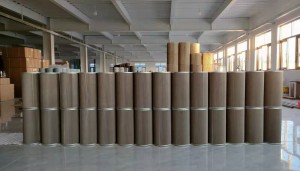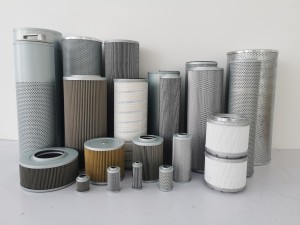Function of hydraulic filter:
The function of hydraulic filter is to filter various impurities in hydraulic system. Its sources mainly include mechanical impurities that remain in the hydraulic system after cleaning, such as water rust, casting sand, welding slag, iron filings, coatings, paint skin and cotton yarn scraps, etc., impurities entering the hydraulic system from the outside, such as dust entering through the refueling port and dustproof ring, etc.; impurities generated during the working process, such as fragments formed by the hydraulic action of seals, metal powders generated by relative wear of movement, colloid, asphaltene, carbon slag, etc. generated by oxidation and deterioration of oil.
Features of hydraulic filter:
1. It is divided into high-pressure section, medium-pressure section, oil return section and oil suction section.
2. It is divided into high, medium and low precision levels. 2-5um is high precision, 10-15um is medium precision, and 15-25um is low precision.
3. To compress the finished filter element dimensions and increase the filtration area, the filter layer is generally folded into a corrugated shape, and the pleating height of the hydraulic filter element is generally below 20 mm.
4. The pressure difference of the hydraulic filter element is generally 0.35-0.4MPa, but some special filter elements are required to withstand high pressure difference, with a maximum requirement of 32MPa or even 42MPa equivalent to the system pressure.
5. The maximum temperature, some require up to 135℃.
Requirements for hydraulic filter elements:
1. Strength requirements, production integrity requirements, pressure difference, installation external force, and pressure difference alternating load.
2. Requirements for smooth oil flow and flow resistance characteristics.
3. Resistant to certain high temperatures and compatible with the working medium.
4. The filter layer fibers cannot be displaced or fall off.
5. Carrying more dirt.
6. Normal use in high altitude and cold areas.
7. Fatigue resistance, fatigue strength under alternating flow.
8. The cleanliness of the filter element itself must meet the standard.
Hydraulic filter replacement time:
Hydraulic excavators generally need to replace hydraulic oil after 2000 hours of operation, otherwise the system will be polluted and cause system failure. According to statistics, about 90% of hydraulic system failures are caused by system pollution.
In addition to checking the color, viscosity, and odor of the oil, the oil pressure and air humidity must also be tested. If working in an environment with high altitude and low temperature, you must also pay close attention to the carbon content, colloids (olefins) and sulfides in the engine oil, as well as the impurities, paraffin and water content in the diesel.
In special cases, if the machine uses low-grade diesel (the sulfur content in diesel is 0.5﹪~1.0﹪), the diesel filter and machine filter should be replaced every 150 hours; if the sulfur content is above 1.0﹪, the diesel filter and machine filter should be replaced every 60 hours. When using equipment such as crushers and vibrating rammers that have a large load on the hydraulic system, the replacement time of the hydraulic return filter, pilot filter and respirator filter is every 100 hours.
Application fields of hydraulic filter element:
1. Metallurgy: used for filtering the hydraulic system of rolling mills and continuous casting machines and filtering various lubrication equipment.
2. Petrochemical: separation and recovery of products and intermediate products in the process of oil refining and chemical production, and particle removal filtration of oil field injection water and natural gas.
3. Textile: purification and uniform filtration of polyester melt in the process of wire drawing, protective filtration of air compressors, deoiling and dewatering of compressed gas.
4. Electronics and pharmaceuticals: pre-treatment filtration of reverse osmosis water and deionized water, pre-treatment filtration of cleaning liquid and glucose.
5. Thermal power and nuclear power: purification of oil in the lubrication system, speed control system, bypass control system of gas turbines and boilers, purification of water supply pumps, fans and dust removal systems.
6. Mechanical processing equipment: purification of lubrication systems and compressed air of papermaking machinery, mining machinery, injection molding machines and large precision machinery, dust recovery filtration of tobacco processing equipment and spraying equipment.
7. Railway internal combustion engines and generators: filtration of lubricating oil and engine oil.
8. Automobile engines and engineering machinery: air filters, oil filters, fuel filters for internal combustion engines, various hydraulic oil filters, diesel filters, and water filters for engineering machinery, ships, and trucks.
9. Various lifting and handling operations: engineering machinery such as lifting and loading to special vehicles such as firefighting, maintenance, and handling, ship's cargo cranes and anchor winches, blast furnaces, steelmaking equipment, ship locks, ship door opening and closing devices, theater's lifting orchestra pits and lifting stages, various automatic conveyor lines, etc.
10. Various operating devices that require force such as pushing, squeezing, pressing, shearing, cutting, and digging: hydraulic presses, metal material die-casting, molding, rolling, calendering, stretching, and shearing equipment, plastic injection molding machines, plastic extruders, and other chemical machinery, tractors, harvesters, and other agricultural and forestry machinery for felling and mining, tunnels, mines, and ground excavation equipment, and various ship steering gears, etc.
11. High-response, high-precision control: tracking drive of artillery, stabilization of turrets, anti-sway of ships, attitude control of aircraft and missiles, high-precision positioning systems of processing machine tools, drive and control of industrial robots, pressing of metal plates, thickness control of leather slices, speed control of power station generators, high-performance vibration tables and testing machines, large-scale motion simulators with multiple degrees of freedom and entertainment facilities, etc.
12. Automatic operation and control of multiple work program combinations: combination machine tools, mechanical processing automatic lines, etc.
13. Special workplaces: operating equipment in special environments such as underground, underwater, and explosion-proof.
Post time: Aug-03-2024



